check engine FIAT SEICENTO 2007 1.G User Guide
[x] Cancel search | Manufacturer: FIAT, Model Year: 2007, Model line: SEICENTO, Model: FIAT SEICENTO 2007 1.GPages: 154, PDF Size: 3.68 MB
Page 79 of 154
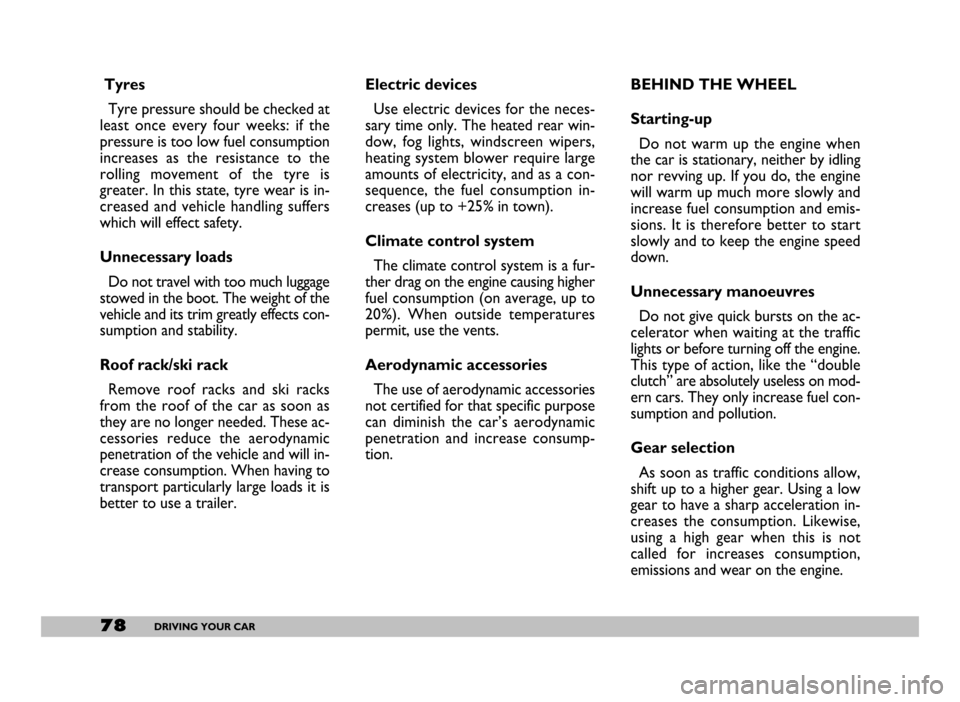
78DRIVING YOUR CAR
Tyres
Tyre pressure should be checked at
least once every four weeks: if the
pressure is too low fuel consumption
increases as the resistance to the
rolling movement of the tyre is
greater. In this state, tyre wear is in-
creased and vehicle handling suffers
which will effect safety.
Unnecessary loads
Do not travel with too much luggage
stowed in the boot. The weight of the
vehicle and its trim greatly effects con-
sumption and stability.
Roof rack/ski rack
Remove roof racks and ski racks
from the roof of the car as soon as
they are no longer needed. These ac-
cessories reduce the aerodynamic
penetration of the vehicle and will in-
crease consumption. When having to
transport particularly large loads it is
better to use a trailer.Electric devices
Use electric devices for the neces-
sary time only. The heated rear win-
dow, fog lights, windscreen wipers,
heating system blower require large
amounts of electricity, and as a con-
sequence, the fuel consumption in-
creases (up to +25% in town).
Climate control system
The climate control system is a fur-
ther drag on the engine causing higher
fuel consumption (on average, up to
20%). When outside temperatures
permit, use the vents.
Aerodynamic accessories
The use of aerodynamic accessories
not certified for that specific purpose
can diminish the car’s aerodynamic
penetration and increase consump-
tion.BEHIND THE WHEEL
Starting-up
Do not warm up the engine when
the car is stationary, neither by idling
nor revving up. If you do, the engine
will warm up much more slowly and
increase fuel consumption and emis-
sions. It is therefore better to start
slowly and to keep the engine speed
down.
Unnecessary manoeuvres
Do not give quick bursts on the ac-
celerator when waiting at the traffic
lights or before turning off the engine.
This type of action, like the “double
clutch” are absolutely useless on mod-
ern cars. They only increase fuel con-
sumption and pollution.
Gear selection
As soon as traffic conditions allow,
shift up to a higher gear. Using a low
gear to have a sharp acceleration in-
creases the consumption. Likewise,
using a high gear when this is not
called for increases consumption,
emissions and wear on the engine.
Page 87 of 154
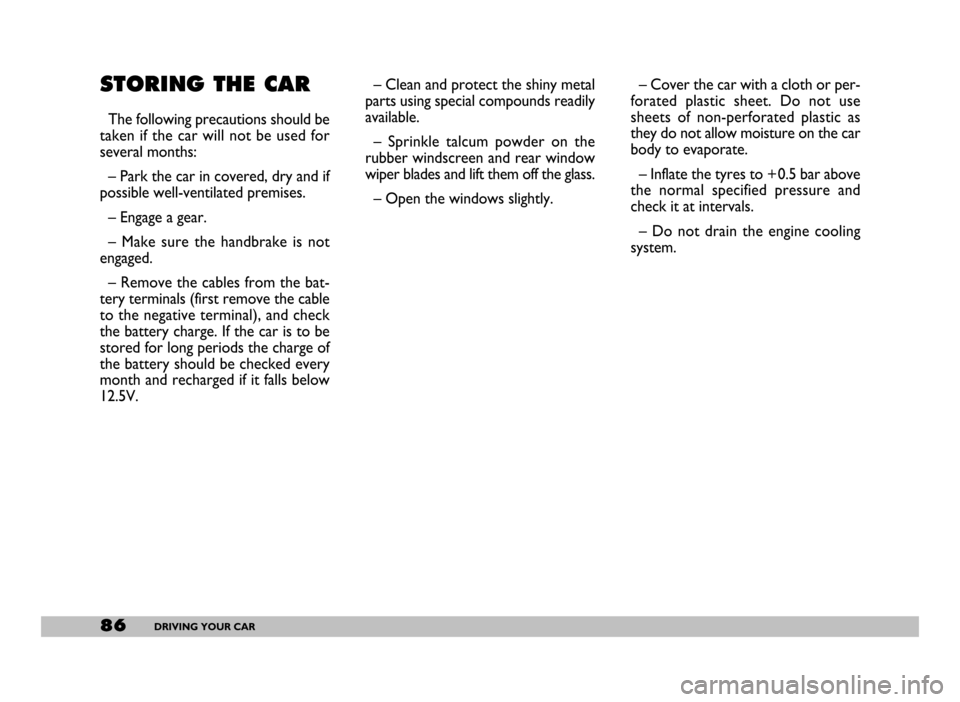
86DRIVING YOUR CAR
STORING THE CAR
The following precautions should be
taken if the car will not be used for
several months:
– Park the car in covered, dry and if
possible well-ventilated premises.
– Engage a gear.
– Make sure the handbrake is not
engaged.
– Remove the cables from the bat-
tery terminals (first remove the cable
to the negative terminal), and check
the battery charge. If the car is to be
stored for long periods the charge of
the battery should be checked every
month and recharged if it falls below
12.5V.– Clean and protect the shiny metal
parts using special compounds readily
available.
– Sprinkle talcum powder on the
rubber windscreen and rear window
wiper blades and lift them off the glass.
– Open the windows slightly.– Cover the car with a cloth or per-
forated plastic sheet. Do not use
sheets of non-perforated plastic as
they do not allow moisture on the car
body to evaporate.
– Inflate the tyres to + 0.5 bar above
the normal specified pressure and
check it at intervals.
– Do not drain the engine cooling
system.
Page 112 of 154

111CAR MAINTENANCE
thousands of kilometres
Check anti-evaporation system
Replace air cleaner cartridge
Top up fluids (engine coolant, brakes, windscreen washer, battery, etc.)
Check timing belt conditions
Replace timing belt (*)
Replace spark plugs
Check engine control systems via diagnostic socket
Check mechanical gearbox oil level
Change engine oil
Replace engine oil filter
Change brake fluid (or every two years) 20 40 60 80 100 120 140 160 180
●●
●●●●
●●●●●●●●●
●●
●
●●●●
●●●●
●●
●●●●●●●●●
●●●●●●●●●
●●●
(*) or every 3 years for demanding use (cold climates, prolonged idling in city traffic)
or every 5 years, regardless of distance
Page 113 of 154

112CAR MAINTENANCE
ANNUAL INSPECTION SCHEDULE
– Inspect conditions of. engine, gear-
box, transmission, piping (exhaust -
fuel feed - brakes), rubber parts
(boots - sleeves - bushings - etc.),
brake and fuel line hoses.
– Check for bonnet and boot lock
cleanness, lever cleanness and lubri-
cation.
– Check battery charge status.
– Check conditions of various con-
trol belts.
– Check and top up fluid levels (en-
gine coolant, brakes, windscreen
washer, battery, etc.).
– Change engine oil.
– Replace engine oil filter.
– Replace pollen filter (where fitted). The following annual inspection
schedule is recommended for
cars travelling less than
20,000 km a year (e.g. approxi-
mately 10,000 km). The schedule
includes the following operations:
– Check tyre condition and wear
and adjust pressure, if required (in-
cluding spare wheel).
– Check operation of lights (head-
lights, direction indicators, hazard
lights, boot light, passenger compart-
ment ceiling light, glove compartment
light, instrument panel lights, etc.).
– Check windscreen wiper/washer
and adjust nozzles.
– Check position wear of wind-
screen/rear window wiper blades.
– Check front brake pad conditions
and wear.
ADDITIONAL
CHECKS
Every 1,000 kmor before long
trips, check and top up as necessary:
– engine coolant level, brake fluid
level, windscreen washer liquid level,
tyre pressure and conditions.
Every 3,000 kmcheck and top up
as necessary: engine oil level.
We recommend using FL Selenia
products which were specifically de-
signed and made for use in Fiat vehi-
cles (see
CAPACITIEStable in TECHNICAL
SPECIFICATIONS
).
Page 114 of 154
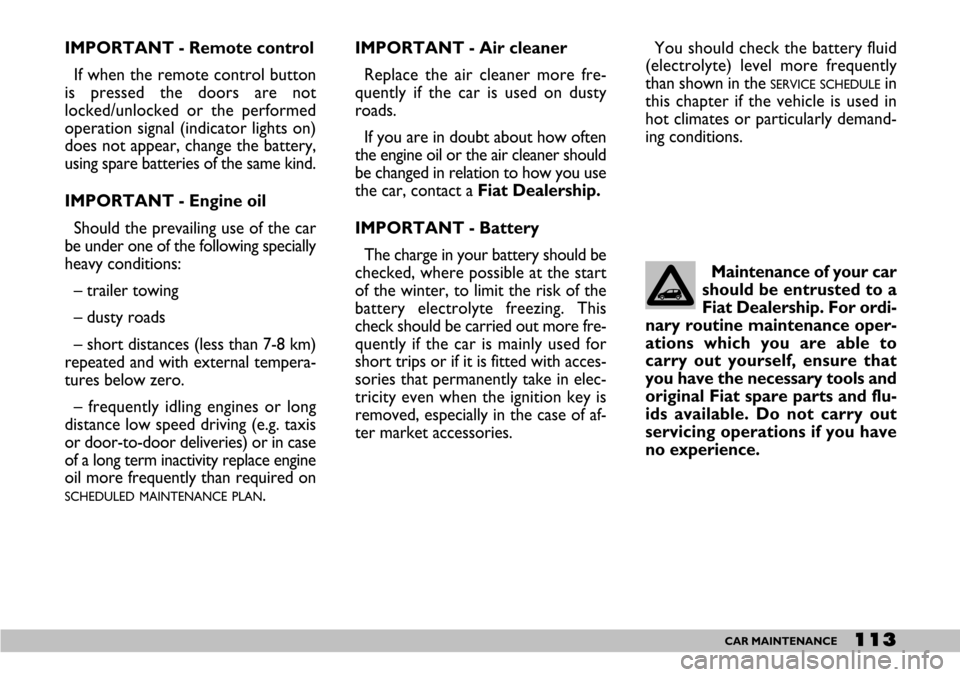
113CAR MAINTENANCE
IMPORTANT - Remote control
If when the remote control button
is pressed the doors are not
locked/unlocked or the performed
operation signal (indicator lights on)
does not appear, change the battery,
using spare batteries of the same kind.
IMPORTANT - Engine oil
Should the prevailing use of the car
be under one of the following specially
heavy conditions:
– trailer towing
– dusty roads
– short distances (less than 7-8 km)
repeated and with external tempera-
tures below zero.
– frequently idling engines or long
distance low speed driving (e.g. taxis
or door-to-door deliveries) or in case
of a long term inactivity replace engine
oil more frequently than required on
SCHEDULED MAINTENANCE PLAN.IMPORTANT - Air cleaner
Replace the air cleaner more fre-
quently if the car is used on dusty
roads.
If you are in doubt about how often
the engine oil or the air cleaner should
be changed in relation to how you use
the car, contact a Fiat Dealership.
IMPORTANT - Battery
The charge in your battery should be
checked, where possible at the start
of the winter, to limit the risk of the
battery electrolyte freezing. This
check should be carried out more fre-
quently if the car is mainly used for
short trips or if it is fitted with acces-
sories that permanently take in elec-
tricity even when the ignition key is
removed, especially in the case of af-
ter market accessories.You should check the battery fluid
(electrolyte) level more frequently
than shown in the
SERVICE SCHEDULEin
this chapter if the vehicle is used in
hot climates or particularly demand-
ing conditions.
Maintenance of your car
should be entrusted to a
Fiat Dealership. For ordi-
nary routine maintenance oper-
ations which you are able to
carry out yourself, ensure that
you have the necessary tools and
original Fiat spare parts and flu-
ids available. Do not carry out
servicing operations if you have
no experience.
Page 115 of 154

114CAR MAINTENANCE
CHECKING FLUID LEVELS
fig. 1
P4Q01038
Do not smoke while
working in the engine
compartment: the pres-
ence of flammable gas and
vapour could cause a fire.
Be very careful: scarves,
ties and other loose arti-
cles of clothing could eas-
ily get caught up in moving parts.
This can be extremely danger-
ous.
1. Engine oil - 2. Battery - 3. Brake fluid - 4. Windscreen washer fluid - 5. Engine
coolant.
Be careful not to mix up
the various types of fluids
when you are topping up:
they are all mutually incompati-
ble and could damage the car. ENGINE OIL
Check engine oil with the car on
level ground and while the engine is
still warm (approximately 5 minutes
after stopping the engine).
The oil level must be between the
MIN and MAX marks on the dipstick
B-fig. 2.The space between MIN and MAX
equals about 1 litre of oil.
If the oil level is near or even below
the MINmark, pour in oil through
the filler hole Auntil it reaches the
MAXmark.
The level of the oil should never ex-
ceed the MAXmark.
Page 116 of 154
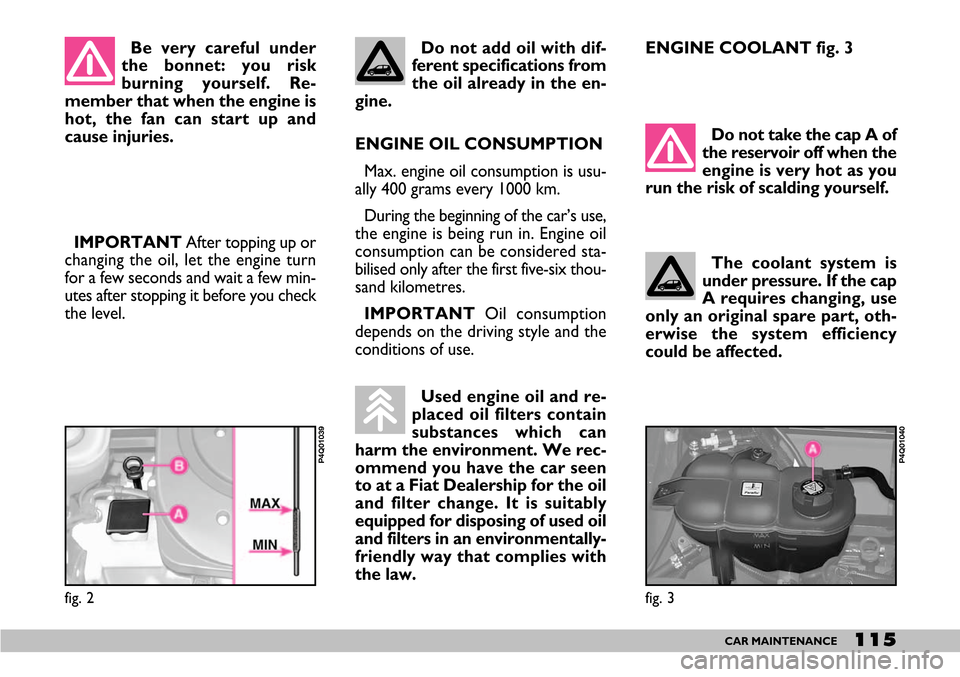
115CAR MAINTENANCE
Be very careful under
the bonnet: you risk
burning yourself. Re-
member that when the engine is
hot, the fan can start up and
cause injuries.
ENGINE OIL CONSUMPTION
Max. engine oil consumption is usu-
ally 400 grams every 1000 km.
During the beginning of the car’s use,
the engine is being run in. Engine oil
consumption can be considered sta-
bilised only after the first five-six thou-
sand kilometres.
IMPORTANTOil consumption
depends on the driving style and the
conditions of use. IMPORTANT After topping up or
changing the oil, let the engine turn
for a few seconds and wait a few min-
utes after stopping it before you check
the level. Do not add oil with dif-
ferent specifications from
the oil already in the en-
gine.
fig. 2
P4Q01039
Used engine oil and re-
placed oil filters contain
substances which can
harm the environment. We rec-
ommend you have the car seen
to at a Fiat Dealership for the oil
and filter change. It is suitably
equipped for disposing of used oil
and filters in an environmentally-
friendly way that complies with
the law.
ENGINE COOLANT fig. 3
Do not take the cap A of
the reservoir off when the
engine is very hot as you
run the risk of scalding yourself.
The coolant system is
under pressure. If the cap
A requires changing, use
only an original spare part, oth-
erwise the system efficiency
could be affected.
fig. 3
P4Q01040
Page 117 of 154
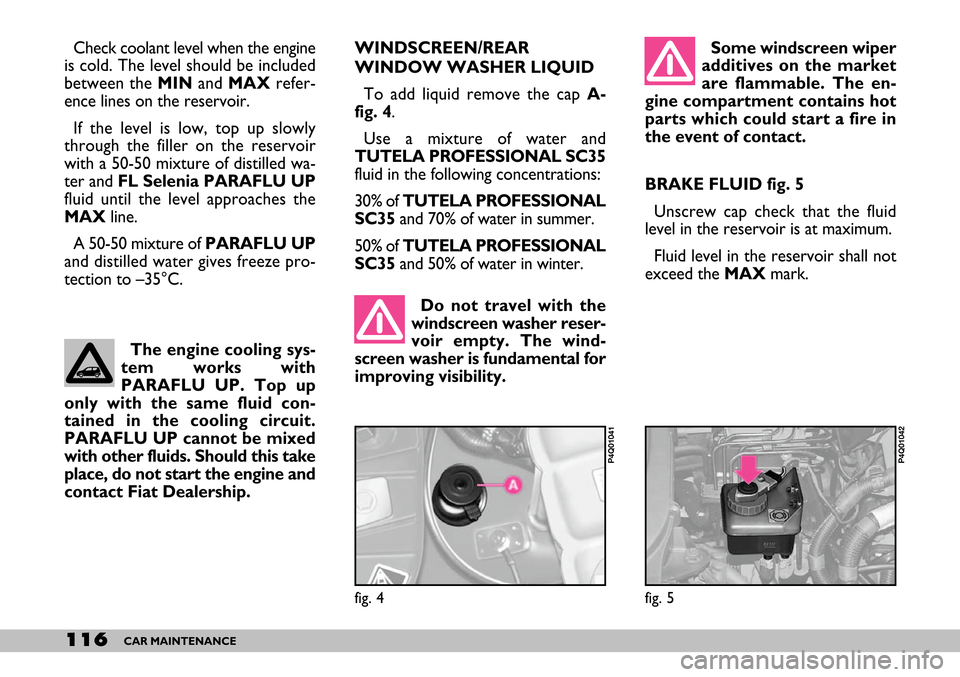
116CAR MAINTENANCE
fig. 5
P4Q01042
Do not travel with the
windscreen washer reser-
voir empty. The wind-
screen washer is fundamental for
improving visibility. Some windscreen wiper
additives on the market
are flammable. The en-
gine compartment contains hot
parts which could start a fire in
the event of contact.
BRAKE FLUID fig. 5
Unscrew cap check that the fluid
level in the reservoir is at maximum.
Fluid level in the reservoir shall not
exceed the MAXmark. Check coolant level when the engine
is cold. The level should be included
between the MIN and MAXrefer-
ence lines on the reservoir.
If the level is low, top up slowly
through the filler on the reservoir
with a 50-50 mixture of distilled wa-
ter and FL Selenia PARAFLU UP
fluid until the level approaches the
MAX line.
A 50-50 mixture of PARAFLU UP
and distilled water gives freeze pro-
tection to –35°C.
The engine cooling sys-
tem works with
PARAFLU UP. Top up
only with the same fluid con-
tained in the cooling circuit.
PARAFLU UP cannot be mixed
with other fluids. Should this take
place, do not start the engine and
contact Fiat Dealership.
WINDSCREEN/REAR
WINDOW WASHER LIQUID
To add liquid remove the cap A-
fig. 4.
Use a mixture of water and
TUTELA PROFESSIONAL SC35
fluid in the following concentrations:
30% of TUTELA PROFESSIONAL
SC35and 70% of water in summer.
50% of TUTELA PROFESSIONAL
SC35and 50% of water in winter.
fig. 4
P4Q01041
Page 120 of 154
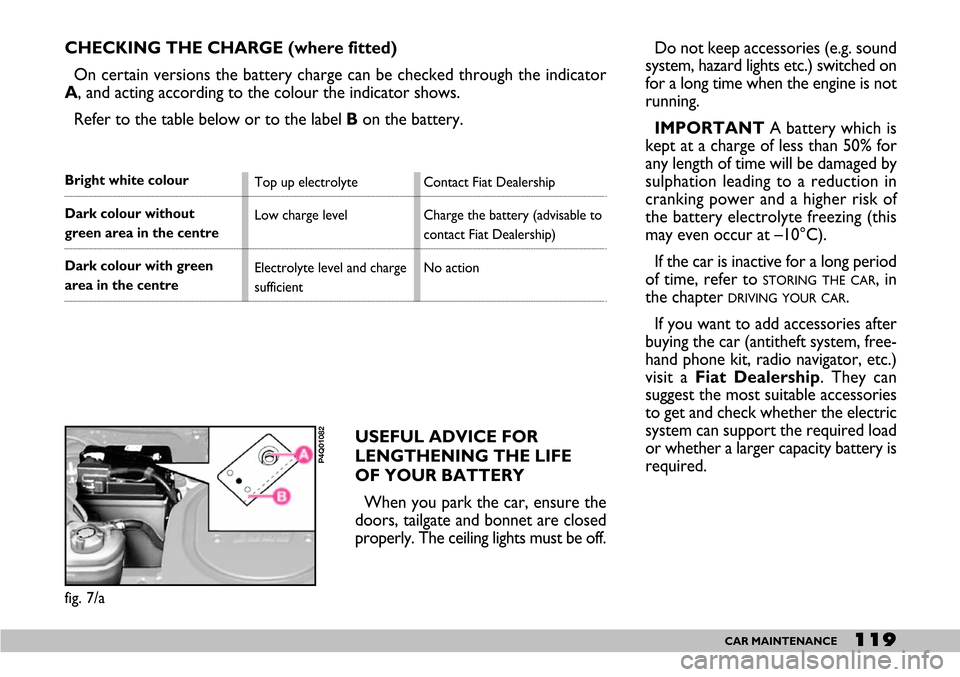
119CAR MAINTENANCE
Do not keep accessories (e.g. sound
system, hazard lights etc.) switched on
for a long time when the engine is not
running.
IMPORTANTA battery which is
kept at a charge of less than 50% for
any length of time will be damaged by
sulphation leading to a reduction in
cranking power and a higher risk of
the battery electrolyte freezing (this
may even occur at –10°C).
If the car is inactive for a long period
of time, refer to
STORING THE CAR, in
the chapter
DRIVING YOUR CAR.
If you want to add accessories after
buying the car (antitheft system, free-
hand phone kit, radio navigator, etc.)
visit a Fiat Dealership. They can
suggest the most suitable accessories
to get and check whether the electric
system can support the required load
or whether a larger capacity battery is
required. USEFUL ADVICE FOR
LENGTHENING THE LIFE
OF YOUR BATTERY
When you park the car, ensure the
doors, tailgate and bonnet are closed
properly. The ceiling lights must be off.
Top up electrolyte
Low charge level
Electrolyte level and charge
sufficientContact Fiat Dealership
Charge the battery (advisable to
contact Fiat Dealership)
No action
CHECKING THE CHARGE (where fitted)
On certain versions the battery charge can be checked through the indicator
A, and acting according to the colour the indicator shows.
Refer to the table below or to the label Bon the battery.
Bright white colour
Dark colour without
green area in the centre
Dark colour with green
area in the centre
fig. 7/a
P4Q01082
Page 121 of 154
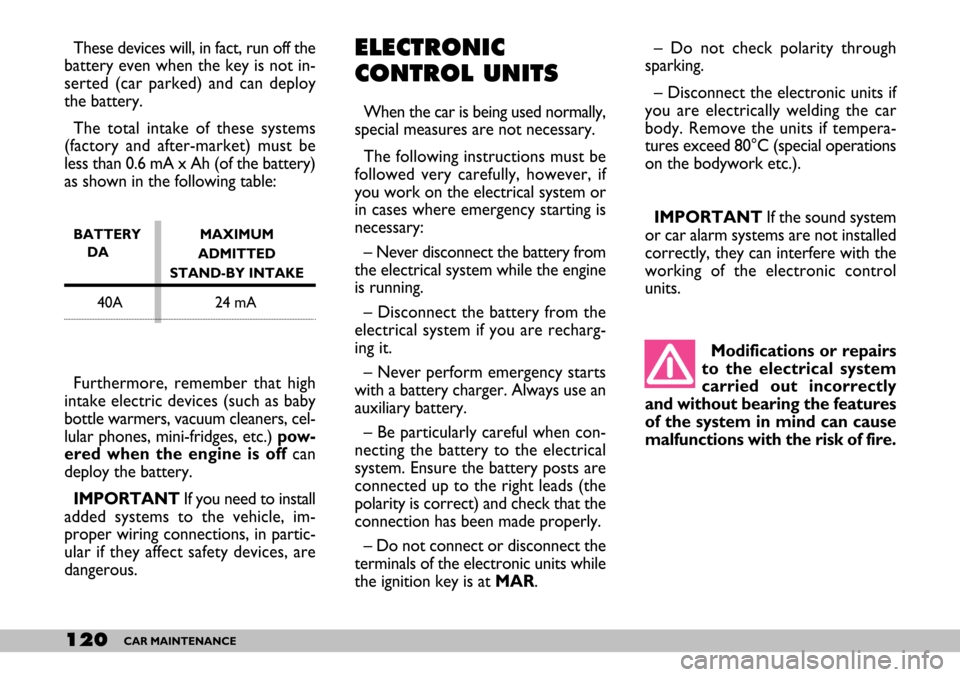
120CAR MAINTENANCE
– Do not check polarity through
sparking.
– Disconnect the electronic units if
you are electrically welding the car
body. Remove the units if tempera-
tures exceed 80°C (special operations
on the bodywork etc.).
IMPORTANTIf the sound system
or car alarm systems are not installed
correctly, they can interfere with the
working of the electronic control
units. ELECTRONIC
CONTROL UNITS
When the car is being used normally,
special measures are not necessary.
The following instructions must be
followed very carefully, however, if
you work on the electrical system or
in cases where emergency starting is
necessary:
– Never disconnect the battery from
the electrical system while the engine
is running.
– Disconnect the battery from the
electrical system if you are recharg-
ing it.
– Never perform emergency starts
with a battery charger. Always use an
auxiliary battery.
– Be particularly careful when con-
necting the battery to the electrical
system. Ensure the battery posts are
connected up to the right leads (the
polarity is correct) and check that the
connection has been made properly.
– Do not connect or disconnect the
terminals of the electronic units while
the ignition key is at MAR. Modifications or repairs
to the electrical system
carried out incorrectly
and without bearing the features
of the system in mind can cause
malfunctions with the risk of fire.
Furthermore, remember that high
intake electric devices (such as baby
bottle warmers, vacuum cleaners, cel-
lular phones, mini-fridges, etc.) pow-
ered when the engine is offcan
deploy the battery.
IMPORTANTIf you need to install
added systems to the vehicle, im-
proper wiring connections, in partic-
ular if they affect safety devices, are
dangerous.
BATTERY
DA
40A 24 mA
MAXIMUM
ADMITTED
STAND-BY INTAKE
These devices will, in fact, run off the
battery even when the key is not in-
serted (car parked) and can deploy
the battery.
The total intake of these systems
(factory and after-market) must be
less than 0.6 mA x Ah (of the battery)
as shown in the following table: